An Expert’s Guide To Pillows, Sheets And Comforters..How To Build Out A Proper Bed, And Where To Buy
If you’ve ever wanted to build out a luxurious bed, it’s important to understand the architecture of the coverings of a mattress from the ground up. That means starting from the mattress protector, which installs directly in contact with the mattress, to the throw pillows, which are the icing on the cake, so to speak.
Here is an illustration of all of the elements that go into making your dream bed, from the bottom up. You can start with the basics first, of course, which generally include sheets, and either a blanket or duvet, and maybe a quilt. One element not shown here, though we include them below in our recommended dealers gallery, is a weighted blanket. they are becoming hugely popular and have excellent health benefits.
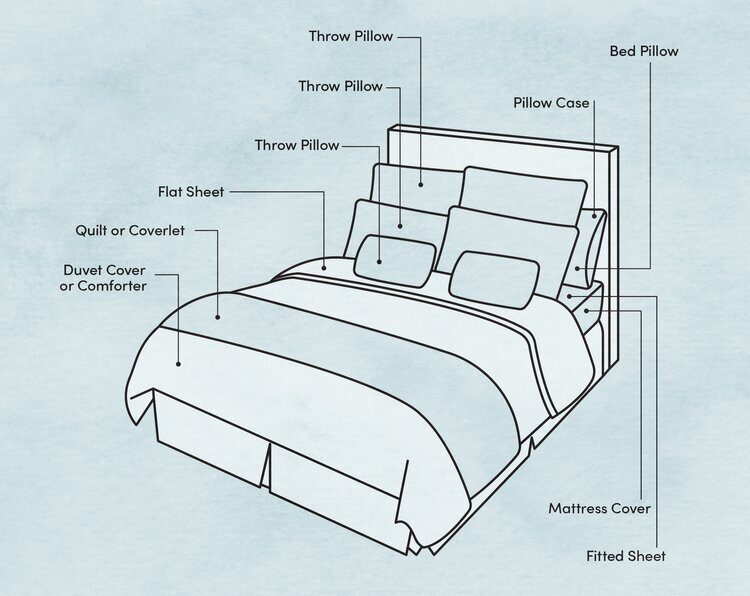
The basic parts of bedding include mattress covers, sheets, a quilt, coverlet, duvet cover, or comforter, and pillows. Here is an overview of the different parts of bedding your bed could include, and where they are placed:
Mattress Covers and Protectors
Protect your investment with a waterproof yet breathable mattress protector. Most mattress protectors today are made using an osmotic film on the underside of the fabric that allows air to breathe, but prevents moisture from entering into the mattress. It will defend your mattress against allergens, dust, and perspiration. Dust mites are notorious around bedding, and using a mattress protector religiously will keep dust mite and dust mite egg cases from gathering by the millions directly in your mattress. A mattress protector will also increase the longevity of your mattress by decreasing the amount of cleaning needed. The protector can be removed and machine washed, though we recommend washing it every two three months, washing your sheets every two weeks.
understanding Sheet basics
A Brief History
Linen was the first fiber used in what were the first set of bed sheets. Linen is a textile made from the fibers of the flax plant, and linen sheets are making a huge comeback. This type of fiber is extremely absorbent. Garments that are made of linen are cherished for their extraordinary coolness in hot weather. The flax plant was cultivated for centuries and were woven and spun by the Egyptians as far back as 3,000 years. While the process of making linen can be very tedious, the results are still worth it.
Europeans first brought linen and the flax plant to the New World. Subsequently, it began to flourish in the colonies, although cultivating linen was extremely time consuming. Early American seamstresses between the 17th to the 19th century worked tirelessly in making bed sheets, pillow cases, towels, and napkins that were made from linen. In the 1830s, cotton became the most prominent manufacturing material in the United States, due to invention of the cotton gin, and industrial improvements in harvesting.
The weave of a particular sheet also determines the feel of the fabric, too. The weave affects the way a sheet feels, the way it looks, its lifespan, and its price. Basic plain weaves, which are woven from an equal number of vertical and horizontal yarns, are least expensive and may not rate a mention on the label. Percale is an upscale plain weave with a thread count of 180 or higher and is known for its longevity and crisp feel.
Most sheets are treated with a mild chemical solution to keep them from shrinking, losing their shape, and wrinkling. Some are treated with alkalis to produce a sheen. Generally, this is not really an issue since the materials are rinsed away using drinkable water before drying and pressing as the material is rolled.
A handful of manufacturers offer pure-finish sheets, meaning that no chemicals were used or that all traces of chemicals used during manufacturing have been removed. You’ll have a harder time keeping these sheets wrinkle-free, but it may be worth it if you suffer from allergies or chemical sensitivities.
Patterns and colors are usually applied to sheets after they’re woven, which means the sheets may feel stiff until you’ve washed them a few times. The softest (and most expensive) colored or patterned sheets, including jacquard weaves, are made of yarn-dyed fabrics, woven from colored yarns.
Sateen weaves have more vertical than horizontal yarns. The higher proportion of vertical threads results in an extremely soft fabric, but one that is more apt to pill and tear than a plain weave. Intricate weaves, such as jacquards and damasks feel textured, with a pattern alternating from satiny soft to coarser and nubby. They can be as durable as plain weaves, but they are made on special looms and are considerably more expensive.
Cotton
Cotton sheets are extremely popular for various reasons. Cotton is one of the easiest materials to wash, it’s breathable which keeps you cool, and cotton gets softer overtime. Also, it’s extremely durable and even after hundreds of washings are still usable and retain their color. Cotton is also a very forgiving fabric, and stains are washed out without problems.
Cotton-polyester blend sheets are wrinkle-resistant, durable (polyester lasts longer than cotton), and relatively inexpensive (up to half the cost of all-cotton). But if you’re looking for that cool, soft feel, nothing beats 100 percent cotton. You’ll hardly ever wake up clammy and damp feeling on cotton sheets, since the fiber wicks moisture away from your skin. And cotton sheets are less likely to stain than polyester blends; a water-loving fiber, cotton releases dirt easily when wet.
All types of cotton share these wonderful traits, but long-staple (or long-fiber) cotton makes for a noticeably softer sheet, and the surface won’t pill and lint like one woven from shorter fibers. The words “Egyptian long-staple,” “pima,” and “Supima” all denote high-quality long fibers.
Flannel
Flannel is a great option, especially for cooler climates and cold nights. Flannel does a great job trapping body heat because of the loftiness of the fiber. Flannel is made of cotton that has essentially been teased and fluffed to be softer. When fibers are combined with flannel, the sheets become much more durable and have a longer life than sheets that are solely made of cotton. Lastly, this fabric is very soft and provide a really cozy sensation against the skin.
Lyocell
Lyocell is made from wood cellulose. Cellulose is a natural material and the fiber is pulled through machines that stretch and dry the cellulose into usable fiber, much like the way a spider produce its silk. Lyocell has been growing in popularity in terms of bed sheets. There are many attractive benefits that lyocell offers. These include the fact that the materials is harvested from a natural renewable resource, encouraging sustainability, hygiene due to its ability to wick moisture away from the body. It is also very durable, and it tends to sleep very cool.
Silk
Silk sheets are perceived by most people as the most luxurious option available. Silk sheets are amazingly cool and rich, shimmering, sensual, and elegant. They are also a great option for anyone who suffers from allergies throughout the year because they are naturally hypoallergenic. They are usually much more expensive than other types of sheets because they are made from a fibre produced by silkworms and require more delicate care. The finest silk comes from silkworms who consume the leaves of the Mulberry tree, and you may often see this iin higher end silk products. However, there are people occasionally who find them difficult and slippery to sleep on.
Polyester
Polyester is usually combined with another fabric to create sheets that are more economical. Polyester sheets are combined with other textiles because they are extremely uncomfortable to sleep on by itself. As a material it’s very coarse and scratchy and is usually used to produce budget friendly sheets and other products. However, some retailers offer great quality polyester and cotton blended sheets, and when blended with enough cotton (say 50%) it’s really hard to tell the difference.
Microfiber
Microfiber is essentially polyester that has been woven very finely. Microfiber sheets are very difficult to stain and are very durable. They are a great choice for children or if you permit pets to sleep with you in bed. Also, microfiber sheets are less breathable than cotton so they’re good for cold weather. Lastly, microfiber is much softer than polyester, which makes the textile much more comfortable to sleep on.
Bamboo
Bamboo fabric is extremely popular now, and make a great option for bed sheets. They are very durable, silky, soft, the most breathable, and are anti-bacterial, anti-fungal, anti-viral, and naturally resist dust mites as well. Bamboo sheets are softer than most fibers, and are again made from a renewable and sustainable resource.
fitted, flat, and pillow cases
Fitted: The fitted sheet is the first layer of bedding. The fitted sheet, complete with an elastic band around the edges, fits snugly on top of your mattress. If you have a mattress protector, it will go on top of that. The elastic prevents the sheet from slipping off of the bed. Make sure all the corners are tucked tightly around the mattress when making your bed.
Flat: Flat (or top) sheets are the next layer to your bedding. They lie on top of the fitted sheet and have the decorative trim at the head of the bed. When sleeping, pull the flat sheet over you for a light layer of warmth. Tuck the flat sheet into the sides and foot of the bed, leaving the top untucked so it can be folded to make room for the pillows.
Pillowcases: These smaller sheet coverings are made specifically to protect your pillows from wear and tear, and to keep them sanitary. We also advise using a pillow protector underneath your pillow case too, as materials like makeup and hair products can seep through standard pillow cases and collect on the surface of your pillow. Pillowcases typically match your fitted and flat sheets, but you can switch up your style by choosing a pillowcase that contrasts in color or design. Any bed larger than a twin or twin extra long, typically has two pillows, so make sure to buy the proper amount of pillowcases. You can check out our pillow page, too if you want to see our choices for premium pillows.
Sheet Sets: Get the best value by choosing a complete sheet set: at least one fitted sheet, flat sheet, and pillowcase. Stock up on sheets in multiples. The rule of thumb is three sets: one for the bed, one for the linen closet, and one in the laundry. Not only does this ensure you always have a clean set at the ready, but it helps minimize wear and tear. Get the best value by choosing a complete sheet set: at least one fitted sheet, flat sheet, and pillowcase. You can check out our list of quality sheets below, either from our selected online retailers, or from Amazon.
Quilts, Coverlets, Duvets and Comforters
From the heaviest comforter to the lightest coverlet, each bedspread offers a different level of warmth, texture, and coziness. These top layers provide added warmth and style, and can be swapped out with the seasons. There are four main options: quilts, coverlets/bedspreads, duvet covers, and comforters.
Quilts: A quilt is made up of three pieces: a top sheet, inner batting, and a bottom sheet. The stitching is usually visible and made into many designs or patterns. They are perfect for colder months, as they can be paired with a heavier layer like a duvet or comforter.
Coverlets/Bedspreads: First of all, to distinguish between a bedspread and coverlet: A bedspread is designed to cover the entire bed, up over the pillows, and down to the floor. Some bedspreads have a special pocket which will accommodate a bedspread filler or insert for a plusher and loftier look as well as adding additional warmth. A coverlet is smaller, designed to cover just the top of the bed and to hang just past the boxsprings.
A coverlet is an extra layer of bedding typically used for decoration or warmth. Since they typically don’t extend far beyond the corners of your bed, coverlets work well in cold climates or winter season as an additional insulate layer on top of your comforter or duvet. However, they are popular for design as well, and can also be used as your primary bedding option in warm climates or seasons.
Duvet & Duvet Covers: First, the difference between a comforter and a duvet is that a comforter is supposed to be used as is, and a duvet is supposed to be used with a duvet cover, coverlet, or top quilt. Sleepers often use a duvet without a top bed sheet, as the duvet cover can readily be removed and laundered as often as the bottom sheet.
Duvets originated in rural Europe (duvet is French for “down”) and were filled with the down feathers of ducks or geese. The best quality is taken from the the eider duck, considered to be the best natural thermal insulator.
In Australian English, a duvet is also called a doona, whereas in American English, it may be called a comforter; however, a comforter is usually a slightly different type of bedding because it is typically not as thick, does not have a cover, and is often used over a top sheet.
A duvet is made up of two soft, flat pieces of fabric, is typically white in color, and is filled with natural down or synthetic fibers (also known as down alternative). Duvets are often paired with a cover to keep them clean. You can choose from many colors or patterns or change it up seasonally. If you are using a duvet cover, you generally don’t need a top flat sheet, though we recommend using one because it keeps from having to wash the duvet cover as frequently. Because of the cover, there is also no need for a top sheet.
Comforters: A comforter is a quilted, fluffy blanket that sits on top of your sheets. It is made up of two breathable pieces of fabric and filled with down or synthetic fibers to add warmth. They are typically one of the heaviest parts of bedding.
Pillows
Pillows are the finishing touch to any bed, and are equally as important as the mattress itself. In fact, it might edge out your mattress a bit, as it is the singular device responsible for supporting, cradling, and suspending your head while you sleep. They play a crucial role in the caliber of your sleep and it’s recommended to replace them every 12 – 18 months as pillow-fill deteriorates and becomes less comfortable. A standard bedding arrangement typically has a combination of bed pillows and throw pillows. Try layering these two types with the largest pillows in the back and the smaller, more decorative ones in the front.
Bed Pillows: Bed pillows are the primary pillows you sleep on every night. Any bed larger than a twin typically has two bed pillows, and they can increase in size as your bed does. For example, a king bed should have king bed pillows. You can also personalize your bed pillows to support your sleep type: back, side, or stomach. There are many different kinds of bed pillows. Some may be the standard dog eared pillow we all are familiar with, others are more low profile and lunette shaped to help with neck issues, others are long and caterpillar like, for use as a body pillow, which can be very beneficial for side sleepers or this with back issues, and even pregnant women
Throw: Decorative pillows (accent or throw pillows) are a quick yet inviting flourish that can turn your bed into a nest or sanctuary. While they serve no purpose ergonomically, their visual appeal can put us in a calming and relaxed mood. Add a dash of style and comfort that’s easy to change at any time. Bedding sets of five or seven pieces often include these as well as pillow shams. The following are the different-shaped throws you can experiment with: throw, lumbar, Euro, and bolster.
If you’re worried about investing in decorative pillows because you like to change up your bedding with the seasons, there’s an easy solution. Shams are decorative covers for throw pillows. You can change them out like you would a pillowcase. Most shams have overlapping flaps in the back that make the throw easy to remove.
Before purchasing sheets and “top of the bed” pieces, measure your mattress’ height, including mattress pads. Remember that padding settles, so measure in at least two spots away from the corners. Buy sheets that are a couple of inches deeper to allow for normal shrinkage.
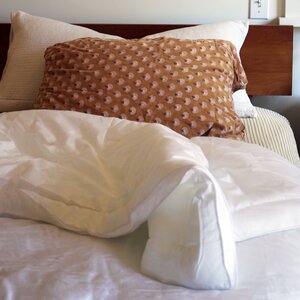
The Buffy Cloud Comforter is made using super-soft eucalyptus fabric and extra-fluffy recycled fill material made from plastic bottles. Softer and fluffier than down. Each comforter keeps 50 plastic bottles out of landfills and protects 12 geese from live plucking. Free trial and free shipping. Click Here.
Apr 23, 2020
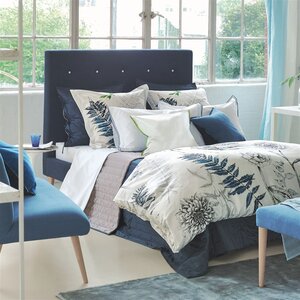
Upscale collection of bedding sets, throws, quilts, sheets in many thread counts and textiles, including Matouk and John Robshaw. Click here to check out one of Marc’s favorite sources for totally unusual bedding gear.
Apr 23, 2020
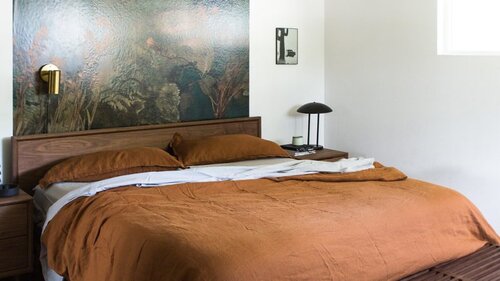
Certified fair trade. Partnered with collectives in Peru and India to create unique and ethically sourced goods. Alpaca and Cotton blankets, throws, duvets, and more. Upscale, discerning. Click here for special pricing. Really unique.
Apr 23, 2020
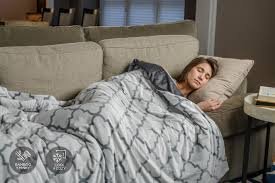
Luxome is a supplier of weighted blankets we love. A weighted blanket embraces, hugs, and calms, giving you restorative sleep like you’ve never had. A purveyor of bamboo sheets as well. Silky, buttery smooth texture, naturally hypoallergenic, anti-bacterial & eco-friendly. Click here for deals.
Apr 23, 2020
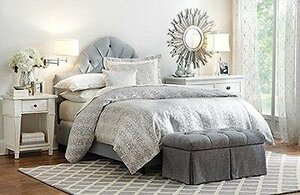
“Fit for a king, but made affordable for you”. Fourth generation family-owned textile mills in Europe guarantee the Riley standard. Broad assortment of anything you’ll need for the top of your bed. Buy direct from their site, save 15%. Sold in Bloomingdales and other high end purveyors. Our exclusive link gets you deals.
Live the life of RiLEY.
Apr 28, 2020
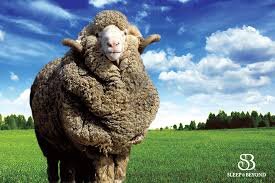
Only the finest and purest nature created raw materials, such as organic Merino wool, natural Shropshire wool, and organic and natural cotton, are used to create Sleep&Beyond’s hypoallergenic products. The company raises their own Merino sheep in the mountainous lands of Kyrgyz Republic, which produce superfine organic wool for their myMerino collection. Our link gets you to their factory direct site.
Apr 28, 2020
Where To Buy A Fantastic Set Of Sheets At Reasonable Prices…Our Hand Selected Portfolio Of Purveyors.
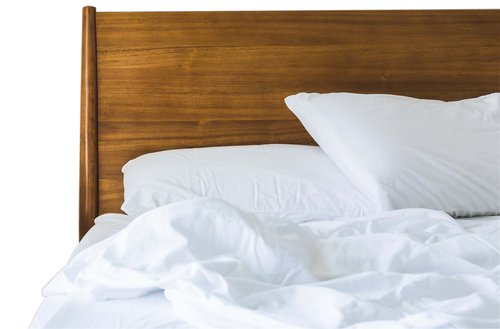
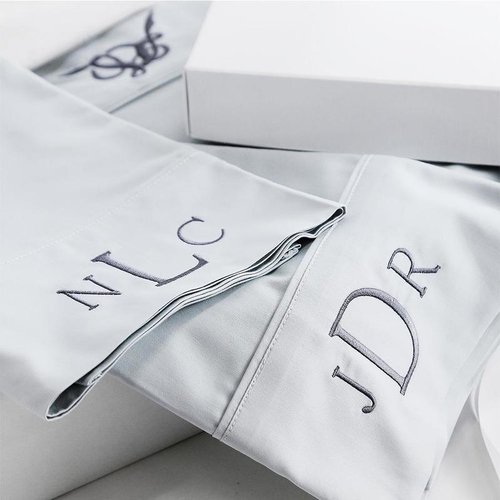
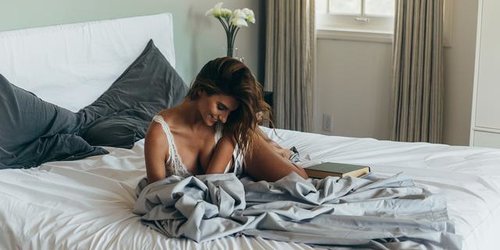
Aanya Linens. Offering a terrfic assortment of sheets at around $80 for a complete set of flat, fitted, and pillows shams. They have a five day ship time, and if you don’t like their sheets, they offer a no hassle return policy. All returned sheets are donated to homeless shelters and charities. Check them out here.
Luxor Linens. From 1200 Thread Count high end luxury sheet sets made using Egyptian cotton (for $269, not $500), to Bamboo, Hotel Grade, Organic, Italian Linens, and even price point sheets, Luxor Linens has the largest array of sheets, comforters, duvets, and eco-friendly top of the bed products we’ve seen. Easy to use web site, hassle free returns. Their Eucalyptus sheets are hugely popular. Check out Luxor Linens here. The company donates proceeds to homeless shelters and even asks customers to recommend shelters to them.
CloudTen. The team at CloudTen has been worked tirelessly over the course of a year to create the best sheets ever made: small-batch crafted, 100% Egyptian Cotton sheets made and hand-checked by European Artisans. Each person who works on CloudTen sheets lives in a developed country with minimum wages, extreme levels of safety certifications, and vacation days.
SheetWorld is proud to design and craft all of our products right here in the USA from premium quality materials. Their baby and toddler sheet sets are 100% cotton to ensure your child gets the most comfortable sleep possible, which also amazingly, assures a better night’s sleep for you! They also craft custom made linens, too.
Morrow Soft Goods. Conceived by friends Stephanie Cleary and Michelle Toney. Coming from the disciplines of fashion and architecture, respectively, they realized their mutual passion for quality home textiles, and an idea was born. They focus on French Linen products, and offer a really cool section of sheets, comforters, duvets, and more. Check them out.

From basic sheets to high end designer selections, Fig Linens is a fun place to shop online. A mindblowing selection of sheets, comforters, faux throws, and much more, presented in an orderly and well structured site. They even offer our favorite comforters, filled with the finest down, made by Matouk. Once on the site, do a search for “sheets” and discover their broad selection of over 80 styles and option. One of our favorites.

A terrific site with a wide variety of bedding and bath related softgoods. We love their monogrammed bath robes and towels, but their lineup of sheets is crazy. Reasonably priced, tons of color options, Egyptian cotton, bamboo, Italian linen, 1000 thread count sets for around $80. Lots of variety and fun to visit. Check it out.
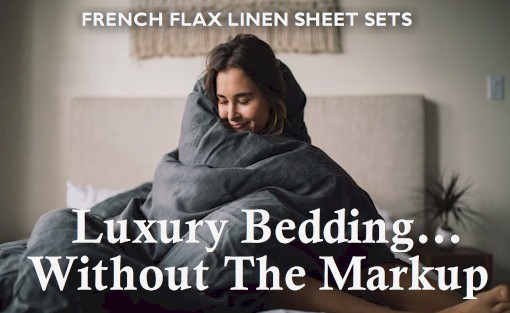

Olive Wren offers extraordinary sheet sets woven from luxurious French flax linen. Flax linen is one of the world’s oldest textiles going back to 8,000 BC. The ancient Egyptians considered flax linen the fabric of the Gods. Their linen is sourced in small batches from Southern France. Flax needs no irrigation and uses much fewer fertilizers/pesticides than cotton, so it’s much better for the environment.partner with factories that produce for the international luxury bedding brands. Each piece is made with integrity and kindness through carefully sourced materials, the finest craftsmanship, and attention to detail. Their fabric is Oeko-Tex Standard 100 certified, meaning they products surpasses the highest criterion of testing for harmful chemicals and synthetics. The most amazing sheets you will ever own.
The Best Sheets You’ll Ever Find…On Amazon
After decades of attending trade shows, conventions, and visiting factories, and selling sheets on our own web sites, we’ve become quite particular about sheets and comforters and duvet covers. Surprisingly, you don’t need mega-high thread count sheets to get the best results. In fact, sheets over 600 thread count can sleep surprisingly hot, since they don’t allow for passive ventilation. We tend to favor cotton, but not necessarily organic cotton, since these sheets can be coarse and scratchy, as say compared to sateen or satin. Bamboo sheets are probably the most popular sheets right now, thanks to their natural and durable fiber, their breathability, and their flexibility and ability to survive endless wash cycles and still having a fresh look. We’ve also included microfiber as well, rapidly becoming a very popular category of sheet options due to their velvety soft feel, without trapping heat. Here are our recommendation for the web’s finest offered at reasonable prices, all hand selected by our team of sheet aficianados. Enjoy!









